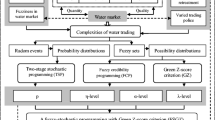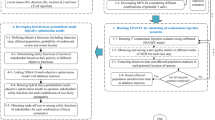Abstract
The contradiction between increasing energy demand, decreasing water availability, and deteriorating ecological environment indicates the urgent necessity for an energy-water-climate nexus management (EWCM) system. The contribution of this paper is to propose a posterior probability-based multi-stage cooperative game and type-2-fuzzy interval-stochastic programming model of the EWCM (PMCTFSP-EWCM) to determine the optimal solutions for sustainable development under ambiguities and uncertainties. The type-2-fuzzy sets and multi-stage interval-stochastic programming are combined to deal with objective and subjective uncertainties of partial parameters with flexible constraints. Moreover, multi-stage cooperative game was adopted to reflect the cooperation and competition between energy subsystem and water resources subsystem. Then, the model was applied to a case study to investigate the EWCM in the Yellow River Basin (YRB), China. Improving water availability satisfaction and feasibility degree can reduce external energy dependence costs from \(\left[84.9, 126.4 \right] \times 10^{9}{\$}\) to \(\left[ 12.7, 14.3 \right] \times 10^{9} {\$}\). Furthermore, when considering the objective function of cost, target revenue functions, and corresponding constraints of the EWCM mutual feedback relationship, the proportion of fossil energy supply in the YRB was reduced to 63.28%-71.79%. These measures could reduce the generation of negative values, which has long-term significance for the healthy and sustainable development of EWCM.








Similar content being viewed by others
Availability of Data and Materials
The data that support the findings of this study can be found online at http://www.yellowriver.gov.cn/doi.org/https://doi.org/10.1016/0165-1889(89)90011-0.
References
Ansari D, Holz F (2019) Anticipating global energy, climate and policy in 2055: Constructing qualitative and quantitative narratives. Energy Res Soc 58:101250
Bloomfield HC, Gonzalez PL, Lundquist JK, Stoop LP, Browell J, Dargaville R, Brayshaw DJ (2021) The importance of weather and climate to energy systems: a workshop on next generation challenges in energy-climate modeling. B Am Meteorol Soc 102:159–167
De G, Tan Z, Li M, Huang L, Wang Q, Li H (2019) A credit risk evaluation based on intuitionistic fuzzy set theory for the sustainable development of electricity retailing companies in China. Energy Sci Eng 7:2825–2841
Di D, Shi Q, Wu Z, Wang H (2023) Sustainable management and environmental protection for basin water allocation: Differential game-based multiobjective programming. Water Resour Manag 37(1):1–20
Egilmez G, Oztanriseven F, Gedik R (2020) The energy climate water nexus: A global sustainability impact assessment of US manufacturing. Eng Manag J 32:298–315
Fulton JL, Ying J (2021) Visualizing the United States electricity-water-climate nexus. Environ Modell Softw 143:105128
Gil E, Morales Y, Ochoa T (2021) Addressing the effects of climate change on modeling future hydroelectric energy production in Chile. Energies 14(1):241
Hu MC, Huang T, Yu HL (2018) Stochastic competitive analysis of hydropower and water supplies within an energy-water nexus. Stoch Environ Res Risk Assess 32:2761–2769
Ji L, Zhang B, Huang G, Wang P (2020) A novel multi-stage fuzzy stochastic programming for electricity system structure optimization and planning with energy-water nexus-A case study of Tianjin, China. Energy 190:116418
Jin SW, Li YP, Yu L, Suo C, Zhang K (2020) Multidivisional planning model for energy, water and environment considering synergies, trade-offs and uncertainty. J Clean Prod 259:121070
Kurze K, Lenschow A (2018) Horizontal policy coherence starts with problem definition: Unpacking the EU integrated energy-climate approach. Environ Policy Gov 28:329–338
Lange MA (2019) Impacts of climate change on the Eastern Mediterranean and the Middle East and North Africa region and the water-energy nexus. Atmosphere 10:455
Lin CH, Chen WH (2023) A technology-organization-environment (TOE) framework based on scientometry for understanding the risk factors in sustainable water resources management. Water Resour Manag 10:1–21
Lv J, Li YP, Shan BG, Jin SW, Suo C (2018) Planning energy-water nexus system under multiple uncertainties-A case study of Hebei province. Appl Energ 229:389–403
Ma XX, Zhang JW, Yu L, Fan YR, Zhang JP (2020) An interval joint-probabilistic stochastic flexible programming method for planning municipal-scale energy-water nexus system under uncertainty. Energ Convers Manage 208:112576
Meng F, Liu G, Liang S, Su M, Yang Z (2019) Critical review of the energy-water-carbon nexus in cities. Energy 171:1017–1032
Mikulčić H, Baleta J, Klemeš JJ, Wang X (2021) Energy transition and the role of system integration of the energy, water and environmental systems. J Clean Prod 292:126027
Namany S, Ansari T, Govindan R (2019) Sustainable energy, water and food nexus systems: A focused review of decision-making tools for efficient resource management and governance. J Clean Prod 225:610–626
Nasrollahi H, Ahmadi F, Ebadollahi M, Nobar SN, Amidpour M (2021) The greenhouse technology in different climate conditions: A comprehensive energy-saving analysis. Sustain Energy Techn 47:101455
Perera AT, Nik VM, Chen D, Scartezzini JL, Hong T (2020) Quantifying the impacts of climate change and extreme climate events on energy systems. Nat Energy 5:150–159
Suo C, Li YP, Wang CX, Yu L (2017) A type-2 fuzzy chance-constrained programming method for planning Shanghai’s energy system. Int J Elec Power 90:37–53
Suo C, Li YP, Mei H, Lv J, Sun J, Nie S (2021) Towards sustainability for China’s energy system through developing an energy-climate-water nexus model. Renew Sust Energ Rev 135:110394
Wang S, Liu Y, Chen B (2018) Multiregional input-output and ecological network analyses for regional energy-water nexus within China. Appl Energ 227:353–364
Wang S, Fath B, Chen B (2019) Energy-water nexus under energy mix scenarios using input-output and ecological network analyses. Appl Energ 233:827–839
Xu S (2020) Governing the energy-water nexus in China: An analysis from the perspective of the science-policy interface. J Environ Manage 272:111119
Yalew SG, Vliet MT, Gernaat DE, Ludwig F, Miara A, Park C, Vuuren DP (2020) Impacts of climate change on energy systems in global and regional scenarios. Nat Energy 5:794–802
Funding
National Natural Science Foundation of China, 52109039, Danyang Di, Key Scientific Research Project plan of Henan Province, 22A570008, Danyang Di, Fourteenth Five-Year Plan of National Key Development, 2022YFC3801004-04, Danyang Di, Key Laboratory Fund of Hydrometeorological Disaster Mechanism and Warning of Ministry of Water Resources, H YMED202208, Danyang Di, China Postdoctoral Science Foundation, 2022TQ0304, Danyang Di, 2022M722879, Danyang Di, Key Specialized Research and Development Breakthrough in Henan Province, No.232102321014, Danyang Di, Zhengzhou University graduate independent innovation project, No.20230434, Danyang Di.
Author information
Authors and Affiliations
Contributions
Conceptualization & methodology, D.D. and H.Z.; methodology, H.H.; software, D.D. and H.H.; validation, D.D.; data curation, D.D. and H.Z.; writing—original draft preparation, D.D.; writing—review and editing, H.Z..
Corresponding author
Ethics declarations
Ethical Approval
N/A.
Consent to Participate
N/A.
Consent to Publish
N/A.
Competing Interests
The authors declare that there are no financial or non-financial competing interests related to this article.
Additional information
Publisher's Note
Springer Nature remains neutral with regard to jurisdictional claims in published maps and institutional affiliations.
Rights and permissions
Springer Nature or its licensor (e.g. a society or other partner) holds exclusive rights to this article under a publishing agreement with the author(s) or other rightsholder(s); author self-archiving of the accepted manuscript version of this article is solely governed by the terms of such publishing agreement and applicable law.
About this article
Cite this article
Di, D., Hu, H. & Zhang, H. A Bayesian Based Multi-stage Type-2-fuzzy Game and Interval-stochastic Programming Method for Planning Basin Energy-water-climate Nexus System. Water Resour Manage 38, 1279–1298 (2024). https://doi.org/10.1007/s11269-023-03720-9
Received:
Accepted:
Published:
Issue Date:
DOI: https://doi.org/10.1007/s11269-023-03720-9




